
Disney live-action adaptations have been hit or miss (well ... mostly miss). One of the biggest complaints has been about the computer-generated images of animal characters. These realistic remakes seem incongruent with the original purpose of the animated features. Disney animators designed animals and inanimate objects with human-like movements and expressions that made their high emotions relatable to viewers — especially younger ones.
It seems difficult for Disney to make animals appealing, emotive, and resemble real life at the same time. The 2019 version of "The Lion King" is one of the worst examples of the realism technique. The lions had an uncanny valley effect, their once-expressive faces reduced to a dead-eyed cipher. A hilarious tweet illustrates how unsettling the CGI is in the scene where Simba notices the incoming stampede. "Photo-real animals look wrong when they talk or sing," /Film's Josh Spiegel wrote of "The Lion King."
So, we've all been nervously anticipating how the fish would appear in Rob Marshall's live-action "The Little Mermaid" (especially after that hellish fan art version of Flounder was floating around the internet). Many were upset when Disney unveiled character posters of Flounder and Sebastian. Twitter users joked that the thinner-looking Flounder got buccal fat removal and Sebastian's tiny eyes and indiscernible mouth made him seem like a shell of his former theatrical, bug-eyed self.
Jacob Tremblay, who voices Flounder, defended the designs during an interview with PEOPLE: "I have to say that I think it really, really worked. I think that they were geniuses and they knew exactly what they were doing." While past criticisms of the realistic designs are certainly warranted (there's a jarring difference between them to the anthropomorphic animations we all know and love from the original films) "The Little Mermaid" live-action really does pull them off well.
A New Take On Beloved Characters

Once you can get past the expectation that the lifelike animals are going to be the same as the beloved animations, it's a lot easier to appreciate their artistry. The live-action fish in "The Little Mermaid" are different, but that doesn't mean they're bad.
In the cartoon, Flounder looks fairly sizeable next to Ariel but in the live-action film, he's super TINY! His petite new scale makes the tension between his size and giant fears even funnier — especially in the scene when they explore the shipwreck. His littleness is absolutely adorable.
Sebastian loses his dramatic flair through the naturalistic design; part of what made him such an iconic character in the original film is his over-the-top reactions. But the way his little wide eyes sit on the top of his head in the live-action design gives him a permanently shocked expression that really works for Daveed Diggs' take on the character: an exasperated crab trying to keep everything calm.
Scuttle is now a diving bird and her wide, light blue eyes and long beak really compliments her abrasive personality. The lifelike designs also make Flotsam and Jetsam a lot scarier as they slither with a lethal silence. Their sharp teeth and pointed eyes seem a lot more deadly than in the cartoon.
The photorealism is splendid in "Under the Sea," showcasing a kaleidoscope of vibrant seahorses, jellyfish, dolphins, and more sea creatures that gently glide in the ocean water. The film finds beauty and humor in their natural, flowing movements like when Ariel sits on the waddling turtles. These visuals fit the song's breezy vibe rather than a Broadway showstopper — but the number is still every bit as exciting. "The Little Mermaid" brings amusement, radiance, and personality to the true-to-life fish designs.
"The Little Mermaid" is currently in theaters.
Read this next: The Top 20 Disney Animated Villains Ranked
The post The Little Mermaid's Creepy, 'Realistic' Fish Are Actually Totally Fine in the Final Movie appeared first on /Film.

